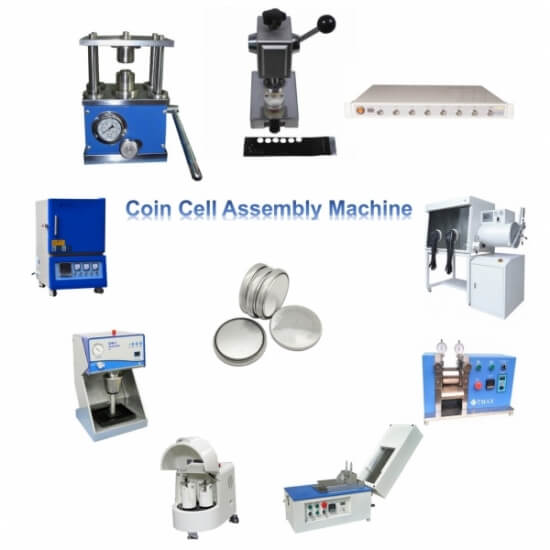Coin Cell Research: Advancing Battery Technology
● Introduction to Coin Cells
Coin cells, also known as button cells, are small, round batteries commonly used in devices such as watches, calculators, remote controls, and medical implants. Despite their diminutive size, coin cells are a crucial area of research in battery technology due to their ubiquitous applications and the growing demand for more efficient, durable, and environmentally friendly energy storage solutions.
● Importance of Coin cell making
1. **Miniaturization**: With the increasing miniaturization of electronic devices, the demand for small, high-performance batteries like coin cells is rising. Research focuses on enhancing the energy density, power output, and longevity of these cells.
2. **Wearable Technology**: Coin cells are integral to the growing market of wearable technology, which requires compact and reliable power sources.
3. **Medical Devices**: Coin cells power critical medical devices such as pacemakers and hearing aids. Improving their performance can significantly impact the health sector.
4. **Environmental Impact**: Developing coin cells with safer materials and improved recyclability is essential for reducing the environmental footprint of battery waste.
● Key Areas of Coin Cell Assembly
1. **Material Innovation**:
- **Electrodes**: Researchers are exploring new materials for electrodes to enhance performance. Traditional materials like zinc and lithium are being supplemented with advanced materials such as graphene, silicon, and transition metal oxides.
- **Electrolytes**: Developing solid-state electrolytes can improve the safety and efficiency of coin cells by reducing the risk of leakage and thermal runaway.
- **Separator Materials**: Innovative separator materials are being studied to enhance ionic conductivity and thermal stability.
2. **Electrode Fabrication Techniques**:
- Techniques such as slurry casting, electrospinning, and chemical vapor deposition (CVD) are used to create electrodes with optimal properties. Ensuring uniformity and maximizing surface area are key goals.
3. **Cell Design and Configuration**:
- The design of coin cells, including the arrangement of electrodes and the selection of packaging materials, plays a significant role in their overall performance. Research aims to optimize these designs for maximum efficiency and durability.
4. **Testing and Characterization**:
- Rigorous testing protocols are essential to evaluate the performance of coin cells. Techniques such as cyclic voltammetry (CV), electrochemical impedance spectroscopy (EIS), and galvanostatic charge-discharge (GCD) are employed to measure key parameters like capacity, energy density, power density, and cycle life.
5. **Environmental and Safety Considerations**:
- Developing eco-friendly coin cells with non-toxic materials and improving their recyclability are critical areas of research. Safety features to prevent overheating and leakage are also paramount.
● Recent Advances in Coin Cell Research
1. **High-Capacity Materials**:
- Researchers have developed silicon-based anodes that offer significantly higher capacity than traditional graphite anodes. However, addressing silicon's expansion during cycling remains a challenge.
2. **Solid-State Electrolytes**:
- Solid-state electrolytes are gaining traction due to their safety and stability advantages over liquid electrolytes. Innovations in materials such as sulfides and garnet-type electrolytes are leading to more robust coin cells.
3. **Flexible and Stretchable Coin Cells**:
- With the rise of flexible electronics, there is a growing interest in flexible and stretchable coin cells. Research in this area focuses on developing materials and designs that can maintain performance under mechanical deformation.
4. **Long-Life Coin Cells**:
- Advances in electrode materials and electrolyte formulations are contributing to coin cells with extended cycle lives, making them more suitable for long-term applications like medical implants and remote sensors.
● Applications and Future Directions
1. **Consumer Electronics**:
- Coin cells continue to be essential for small electronics, where space is at a premium, and reliable power is crucial.
2. **Wearable Devices**:
- The expanding market for fitness trackers, smartwatches, and other wearable devices drives the need for improved coin cell performance.
3. **Medical Devices**:
- High-reliability coin cells are critical for life-saving medical devices, and ongoing research aims to enhance their safety and longevity.
4. **Internet of Things (IoT)**:
- As IoT devices proliferate, the demand for efficient, small-scale batteries like coin cells will grow. These devices often require long-lasting power sources that can operate in varied environments.
● Conclusion
Coin cell research is a dynamic field that plays a vital role in advancing battery technology. By focusing on material innovation, advanced fabrication techniques, and rigorous testing, researchers aim to enhance the performance, safety, and environmental impact of these ubiquitous energy storage devices. As technology continues to evolve, coin cells will remain a cornerstone of many applications, from consumer electronics to medical devices, driving the need for continued research and development in this area.




 ONLINE
ONLINE Louis@lithmachine.com
Louis@lithmachine.com +0086 15959378975
+0086 15959378975